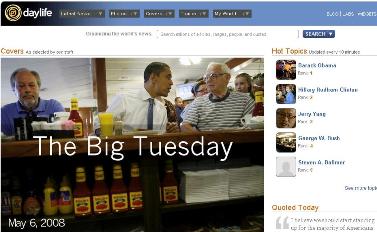Daylife Poised to Reinvent News and Online Content Distribution, with Funding from Publicis, NY Times Company and a Digital Who's Who.

Jonathan Harris was an artist studying computer science at Princeton. His early art project, 10x10, extracted text and images from newsfeeds to build a matrix. The site would ultimately generate ten million visitors. Among them was Upendra Shardanand, an MIT undergrad who made his name and fortune selling his personalization software (MSN Passport) for $40M. A news aficionado himself, he saw in 10x10 the future of news aggregation.
Shardanand, as CEO and co-founder, with Harris as design director, launched Daylife (www.daylife.com) in stealth back in 2005. Daylife taps every mainstream news service and major news blog, across the globe. That's 7,500 sources and counting. While news aggregators are geared to the news reader, none of them were simultaneously designed with the publisher or advertiser in mind. Daylife acquires content, classifies and indexes it in a granular fashion. This enables Daylife to identify connections, ranging from obvious to the counterintuitive. And "connections," says co-founder Tom Tercek, "provide context."
The shop has since had two rounds of funding with early investment from the New York Times Co., venture capital firms Arts Alliance Digital Ventures and Bebo backer Balderton Capital, as well as the braintrust of such digerati as Jeff Jarvis, Craig’s List’s Craig Newmark, and TechCrunch's Michael Arrington. Daylife is also a portfolio firm of Publicis Group's Denuo - its media futures unit - and many of its staffers have joined Daylife, including Tercek, who has a background split between media companies and tech startups with stints at Shardanand's Firefly Network, AtomFilms, and MTV Networks. In an exclusive interview with JackMyers Media Business Report, Tercek described why the Daylife platform represents a new architecture for web delivery of news and content.
Daylife’s value proposition is elegantly simple. It “tames the river of news" through a proprietary technology that provides sites with depth of content on targeted topics from around the web. Daylife enables sites to add relevant news, photos, quotes and contextual insights, dramatically expanding the wealth of content and information available to site visitors, and enhancing the site’s search engine ratings. The additional content, which site editors control and which is delivered through a fully automated program, attracts added users and increases page views and time. Daylife licenses its API (application programming interface) to publishers with an initial focus on the sites of leading content suppliers such as USA Today, The Daily Telegraph, NewarkStar-Ledger, Huffington Post, Washingtonpost.com, CNNMoney.com, TBS, and Parade. Major marketers, led by Purina,are utilizing Daylife to expand their sites’ value to consumers.
"Publishers we're speaking with realize it's no longer enough just to deliver their perspective, and they see the value in adding depth of relevant content," Tercek explains. With Royal Caribbean's ad sponsorship, USA Today expanded Cruise Log, a blog by staffer Gene Sloan, into an entire online section without additional staffers. With Daylife, USA Today created topic pages for every cruise company, major cruise destinations, and specialized cruise features, delivering multiple and continuously updated news feeds, photos and relevant insights to each topic page from websites identified by Sloan. It is completely automated and 100 percent driven by Daylife except for Sloan’s regular blog. For users it's a compelling and content-rich destination establishing Cruise Log as a dominant destination for travelers. “In the process blogger Sloan has been transformed from writer to curator,” says Tercek. The result has been a 600 percent surge in traffic. This Monday, USA Today launched a second niche travel section, Today in the Sky. Similarly, Daylife has built a Major League Baseball portal for TBS, generating topic pages for every major league team, and they will be working with both the NHL and NBA.
Branded entertainment continues to expand in popularity in TV and online video, and Daylife enables a branded content model for online news content. Tercek explains that using Daylife, pet food marketer Purina created Pet Charts to transform its site from exclusively company-created content to an aggregator of pet-related news, information and photography from around the web. Pet Charts captures images from Flickr, video from YouTube and news from a limited number of sites pre-defined by Purina. Content is vetted once daily; otherwise it's entirely automated. “You'll be seeing marketers shifting into this role of publisher and aggregator, becoming trusted sources," suggests Tercek. He advises there has been "tremendous interest" from the public relations industry.
In addition to breaking articles on specific topics, delivering just published images from Getty, Reuters, and Associated Press, plus intuiting connections among content offerings, Daylife enhances content by extracting quotes from stories. "Not only," remarks Tercek, "do people love quotes but we've found that they are valuable as a navigational tool." Depending on the size of publishers and their goals, Daylife's APIs can easily be customized and deployed with minimal engineering and editorial oversight.
Jonathan Harris' contribution to information design has brought news into the 21st century. The news visualization of Marumishi's newsmap (which indexes Google News according to topic) has evolved into a customizable solution. Clients have developed indices, (Treehugger's Green Index, Washington Post's Issue Coverage Tracker) as well as cultural barometers (Fortune's Meme-O-Meter ranks topics in digital media, including "TV on the Internet" against frequency). Daylife’s Red Carpet (http://redcarpet.daylife.com/) not only serves celebrity images but cross-indexes celebrity sightings with parties and cities, and enables publishers to organize galleries around topics and, through widgets, deliver these galleries to individual user pages at Facebook and MySpace.
Tercek adds that Daylife is constantly innovating in content delivery models at Daylife Labs (http://labs.daylife.com/), with a dozen projects currently under development and available for review. Daylife may represent one of those major innovations that radically alters the media landscape, enabling publishers and marketers to focus their resources on their core capabilities while delivering deep and wide relevant content to their audiences and customers.
In June, Daylife will unveil a roster of new partnerships and expanded business models to serve both major and highly targeted small publishers, and even individual bloggers. JackMyers Media Business Report is exploring a relationship with Daylife and we will be tracking the company’s progress for our readers.
For more information, contact partners@daylife.com.


